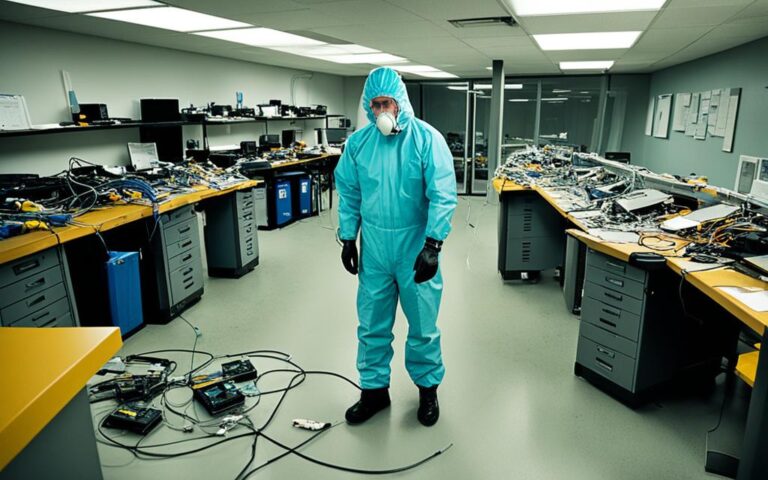Salvaging for Sustainability: Environmental Workstation Recovery
Data centers play a vital role in our digital world, but as technology advances, older data centres often become obsolete, requiring decommissioning. Proper disposal of decommissioned data centres is crucial for data security and environmental sustainability. This section explores sustainable practices for responsible disposal in data centre decommissioning, highlighting environmentally friendly solutions and their benefits.
Conducting an Environmental Assessment
Before undertaking the decommissioning process, it is crucial to conduct a comprehensive environmental assessment. This assessment will identify potential environmental hazards, including toxic materials and hazardous waste, which will enable the implementation of appropriate measures during the decommissioning and disposal stages. Understanding the environmental impact is key to developing sustainable strategies for responsible disposal.
During the environmental assessment, data center professionals will evaluate various factors that can impact the environment. This includes analyzing the types and quantities of waste generated, assessing the presence of harmful substances, and evaluating the existing infrastructure. By conducting a thorough assessment, organizations can gain an accurate understanding of the environmental risks associated with the decommissioning process.
“The environmental assessment is a critical step in ensuring the responsible decommissioning of data centers. It allows us to identify any potential environmental risks and develop appropriate strategies to mitigate them. By prioritizing sustainability from the onset, we can make informed decisions that have a positive impact on our environment.”
– Jane Foster, Environmental Consultant at Green Solutions Ltd.
Once the environmental assessment is complete, organizations can use the information gathered to develop sustainable strategies for responsible disposal. These strategies may include implementing recycling programs, repurposing equipment, and optimizing waste management processes. The goal is to minimize the environmental impact of decommissioning while maximizing the reuse and recovery of valuable resources.
Benefits of Conducting an Environmental Assessment:
- Identifies potential environmental hazards
- Enables the implementation of appropriate measures
- Helps develop sustainable strategies for responsible disposal
- Minimizes the environmental impact of decommissioning
- Maximizes the reuse and recovery of valuable resources
By conducting a thorough environmental assessment, organizations can lay the foundation for environmentally-conscious decommissioning practices. This not only ensures compliance with regulatory requirements but also contributes to a more sustainable future for the data center industry.
Prioritizing Recycling and Reuse
When decommissioning data center components, it is crucial to prioritize recycling and reuse instead of disposing of them entirely. This sustainable approach not only reduces electronic waste but also contributes to a greener future. By working with certified e-waste recyclers, organizations can ensure the proper handling and disposal of electronic components, minimizing the environmental footprint.
Functional equipment that may no longer serve its original purpose can still find new life through repurposing or donation to organizations in need. Extending the lifecycle of these components through reuse reduces the demand for new resources and further minimizes electronic waste generation. Embracing recycling and reuse practices not only benefits the environment but also creates opportunities for collaboration and social responsibility.
“We believe in the power of recycling and reusing electronic components. By diverting them from landfills and engaging in sustainable practices, we can make a meaningful impact on the environment.” – [Company Name]
The Benefits of Recycling and Reuse
Recycling and reusing electronic components offer several key benefits:
- Reduces environmental impact: By diverting electronic waste from landfills, recycling and reusing components help conserve natural resources and reduce pollution caused by improper disposal methods.
- Conserves energy and raw materials: Recycling electronic components requires less energy and fewer raw materials compared to manufacturing new ones, leading to significant energy and resource savings.
- Promotes circular economy: Embracing recycling and reuse practices fosters a circular economy, where products and materials are kept in use for as long as possible, reducing waste and promoting sustainability.
- Supports local communities: Donating functional equipment to organizations in need not only extends the component’s lifecycle but also contributes to societal development and helps bridge the digital divide.
By prioritizing recycling and reuse, organizations can take a proactive role in reducing electronic waste and promoting a more sustainable future.
Example of Recycling and Reuse in Data Centers
Many technology companies have recognized the importance of recycling and reusing electronic components. Here is an example of [Company Name]’s initiative:
| Company | Recycling and Reuse Initiatives |
|---|---|
| [Company Name] | – Established partnerships with certified e-waste recyclers to responsibly dispose of decommissioned electronic components. – Implemented an internal program to identify functional equipment suitable for repurposing or donation to local community organizations in need. – Tracked and reported the environmental impact of recycling and reuse activities, showcasing the company’s commitment to sustainability. |
Ensuring Secure Data Destruction
Data security is of utmost importance when decommissioning a data centre. Proper data destruction techniques must be employed to ensure sensitive information does not fall into the wrong hands. By utilizing certified data destruction methods, such as physical destruction of hard drives or secure data wiping techniques that meet recognized standards, organisations can safeguard their data and protect their clients’ privacy. It is essential to partner with reputable data destruction services that guarantee compliance with legal and industry regulations, ensuring responsible disposal and mitigating the risk of data breaches.
The Importance of Secure Data Destruction
Secure data destruction is crucial for maintaining the integrity of sensitive information during the decommissioning process. Without proper data destruction, data stored on decommissioned devices such as hard drives and solid-state drives (SSDs) can be recovered and exploited by malicious individuals. To protect against this, organizations must adopt secure data wiping techniques or physical destruction methods that render the data irretrievable.
“Secure data destruction is not just about deleting files or formatting hard drives. It involves effective techniques that eliminate any traces of sensitive information, ensuring its unrecoverability.”
Secure Data Wiping Techniques
Secure data wiping techniques involve overwriting the entire storage medium with random data patterns multiple times, effectively erasing any existing data. There are several recognized standards for data wiping, such as the Department of Defense (DoD) 5220.22-M standard and the National Industrial Security Program Operating Manual (NISPOM) standard. These guidelines outline the number of overwrite passes required to ensure data irretrievability based on the sensitivity level of the information.
| Data Wiping Standard | Number of Overwrite Passes | Sensitivity Level |
|---|---|---|
| DoD 5220.22-M | 7 | Medium |
| NISPOM | 3 | Low |
Data destruction service providers employ software tools that adhere to these standards, ensuring complete erasure of data and minimizing any residual risks. By engaging certified data destruction services, organizations can confidently dispose of decommissioned equipment, knowing that the data contained within has been irreversibly erased.
Physical Destruction of Hard Drives
Physical destruction of hard drives involves physically damaging the drive to render it unusable and the data irretrievable. Common methods include shredding, crushing, or disassembling the hard drives. Organizations must select a certified e-waste recycler that follows recommended practices for physical destruction, including responsible recycling of the resulting materials. This approach guarantees data security while also promoting environmental sustainability.
Partnering with Reputable Data Destruction Services
To ensure compliance with legal and industry regulations, it is crucial for organizations to partner with reputable data destruction service providers. These providers possess the expertise and certifications necessary to handle data destruction securely and responsibly. By entrusting the process to professionals, organizations can focus on their core operations without the fear of data breaches.
Partnering with renowned data destruction companies also offers the added benefit of auditability and documentation. Detailed reports are generated, documenting each step of the data destruction process, including proof of compliance with relevant standards. This documentation can be crucial when demonstrating regulatory compliance and fulfilling internal or external auditing requirements.
By prioritizing secure data destruction, organizations can safeguard sensitive information, protect their clients’ privacy, and adhere to regulatory standards. Employing certified data destruction methods and partnering with reputable service providers ensures responsible disposal and instils confidence in stakeholders that data security is taken seriously.
Embracing Energy Recovery and Renewable Solutions
Data centers are known for their substantial energy consumption. However, when it comes to decommissioning, there are opportunities to embrace energy recovery and renewable solutions, reducing the environmental impact. By salvaging and reusing viable equipment, such as generators or UPS systems, data centers can contribute to energy generation and minimize waste. Additionally, investing in renewable energy sources, such as solar or wind power, during the decommissioning process can offset energy consumption and promote a more sustainable approach.
Furthermore, integrating energy recovery systems can harness the thermal energy generated by data centers, transforming it into usable energy. For instance, waste heat recovery can be achieved through techniques like heat exchangers, which capture and repurpose the excess heat to warm water or other applications. By maximizing energy efficiency through these initiatives, data centers can significantly reduce their carbon footprint and contribute to a cleaner, greener future.
To illustrate the potential benefits of energy recovery and renewable solutions, take a look at the following table comparing the environmental impact of traditional decommissioning methods with those that focus on energy recovery:
| Traditional Decommissioning | Energy Recovery | |
|---|---|---|
| Carbon Emissions | High | Significantly reduced |
| Waste Generation | Large volume | Minimized through recycling and reuse |
| Energy Consumption | No offset | Offset through renewable sources |
As evident from the table, energy recovery and renewable solutions offer substantial advantages in terms of carbon emissions, waste generation, and energy consumption. By adopting these initiatives, data centers can play a pivotal role in preserving the environment and promoting sustainability within the industry.
Quoting Michael Johnson, CEO of GreenTech Solutions:
“Energy recovery and renewable solutions are imperative for the future of data center decommissioning. By repurposing equipment, harnessing waste heat, and embracing renewable energy sources, data centers can drastically reduce their environmental impact and set the standard for sustainable practices within the industry.”
By prioritizing energy recovery and renewable solutions during the decommissioning process, data center operators can not only minimize their ecological footprint but also serve as role models for other industries. The shift towards sustainable practices in data center decommissioning is a crucial step towards a greener, more sustainable future.
Documentation and Reporting
Maintaining accurate documentation throughout the decommissioning process is essential for ensuring compliance and accountability. By recording key details and progress, organizations can track their environmental efforts and demonstrate their commitment to sustainable practices.
Documentation serves as a comprehensive record of the decommissioning process. It includes information such as the volume and type of waste generated, recycling and disposal methods employed, and the carbon emissions offset through the use of renewable energy sources. This data enables organizations to precisely track progress and identify areas that require improvement.
While tracking progress, organizations can use documentation to measure their environmental performance against set targets and objectives. Comparing the actual results with set standards and benchmarks helps in evaluating the efficiency and effectiveness of the decommissioning process.
Future planning and decision-making benefit from a documented history
Furthermore, documentation aids in building a future-oriented approach to workstation recovery projects. By maintaining a detailed record, organizations can refer back to past projects, analyze trends, and identify opportunities for innovation and optimization. This historical perspective provides valuable insights for future planning and decision-making.
Benefits of Comprehensive Documentation
The benefits of maintaining comprehensive documentation throughout the decommissioning journey are numerous, including:
- Promoting transparency and accountability in environmental efforts
- Facilitating compliance with legal and regulatory requirements
- Identifying opportunities for process improvement and enhanced efficiency
- Supporting the development of sustainability reports and certifications
Monitoring and tracking progress through accurate documentation is crucial to ensuring a successful and environmentally responsible data center decommissioning process.
Example Documentation Table
| Date | Volume of Waste Generated | Recycling Methods | Disposal Methods | Carbon Emissions Offset |
|---|---|---|---|---|
| October 2022 | 3 metric tons | Component recycling, e-waste recycling | Certified disposal facility | 10 metric tons CO2 equivalent |
| November 2022 | 2.5 metric tons | Equipment repurposing, metal recycling | Donation to local schools, recycling center | 8 metric tons CO2 equivalent |
| December 2022 | 4 metric tons | Component recycling, electronics refurbishment | Recovery and resale of functional equipment, e-waste recycling | 12 metric tons CO2 equivalent |
Conclusion
Data center decommissioning presents a valuable opportunity for organizations to embrace environmental workstation practices and ensure responsible disposal. By prioritizing recycling and reuse, implementing secure data destruction methods, and embracing energy recovery and renewable solutions, we can make significant strides in reducing the environmental impact of decommissioning projects.
By choosing to recycle and reuse electronic components, we can extend their lifecycle and minimize electronic waste. Working with certified e-waste recyclers not only ensures proper disposal but also contributes to a more sustainable future. Additionally, repurposing functional equipment or donating it to organizations in need can further reduce waste and benefit the community.
Ensuring secure data destruction is another crucial aspect of responsible disposal. By opting for certified data destruction methods or secure data wiping techniques, organizations can safeguard sensitive information and comply with legal and industry regulations. Partnering with reputable data destruction services guarantees data security and promotes responsible practices.
Moreover, embracing energy recovery and renewable solutions can significantly mitigate the environmental impact of decommissioning. Salvaging and reusing equipment that generates energy, such as generators or UPS systems, can contribute to reducing energy consumption. Additionally, investing in renewable energy sources like solar or wind power for the decommissioning process promotes sustainability and helps offset energy consumption.
In conclusion, by adopting these environmental workstation practices and prioritizing responsible disposal during data center decommissioning, organizations can contribute to a greener, more sustainable future. Through recycling, secure data destruction, and embracing energy recovery and renewable solutions, we can pave the way for a more eco-friendly approach to data center decommissioning and make a positive impact on the environment.
FAQ
What role do data centers play in our digital world?
Data centers play a vital role in our digital world by storing and processing large amounts of data, enabling the functioning of various online services and applications.
Why is proper disposal of decommissioned data centers important?
Proper disposal of decommissioned data centers is crucial for data security and environmental sustainability. It ensures that sensitive information is not compromised and reduces the environmental impact of electronic waste.
What is the significance of conducting an environmental assessment before decommissioning a data center?
Conducting an environmental assessment helps identify potential environmental hazards and develop sustainable strategies for responsible disposal during the decommissioning process.
How can recycling and reuse be prioritized during data center decommissioning?
By working with certified e-waste recyclers and repurposing functional equipment, data center components can be recycled and reused, reducing the environmental footprint and extending their lifecycle.
What methods should be used for secure data destruction during decommissioning?
Certified data destruction methods such as physical destruction of hard drives or secure data wiping techniques should be employed to ensure that sensitive information does not fall into the wrong hands.
How can energy recovery and renewable solutions be embraced during data center decommissioning?
Salvaging and reusing equipment that can contribute to energy generation, as well as investing in renewable energy sources like solar or wind power, can offset energy consumption and promote a more sustainable approach during decommissioning.
Why is documentation and reporting important in data center decommissioning?
Maintaining accurate documentation throughout the decommissioning process enables organizations to track progress, identify areas for improvement, and demonstrate their commitment to sustainable practices and responsible disposal.















